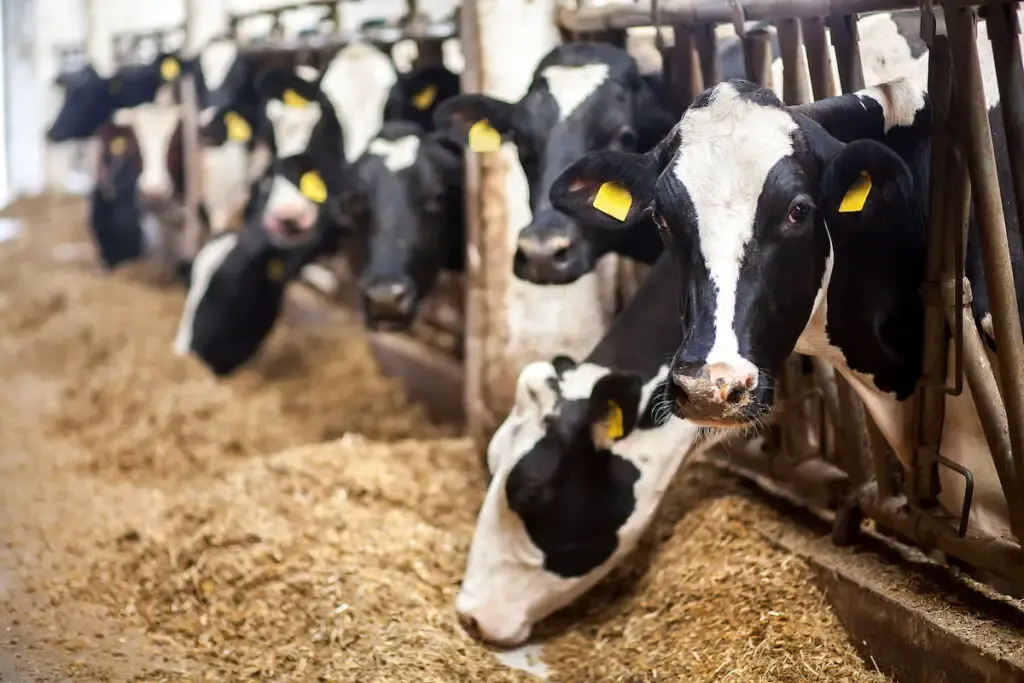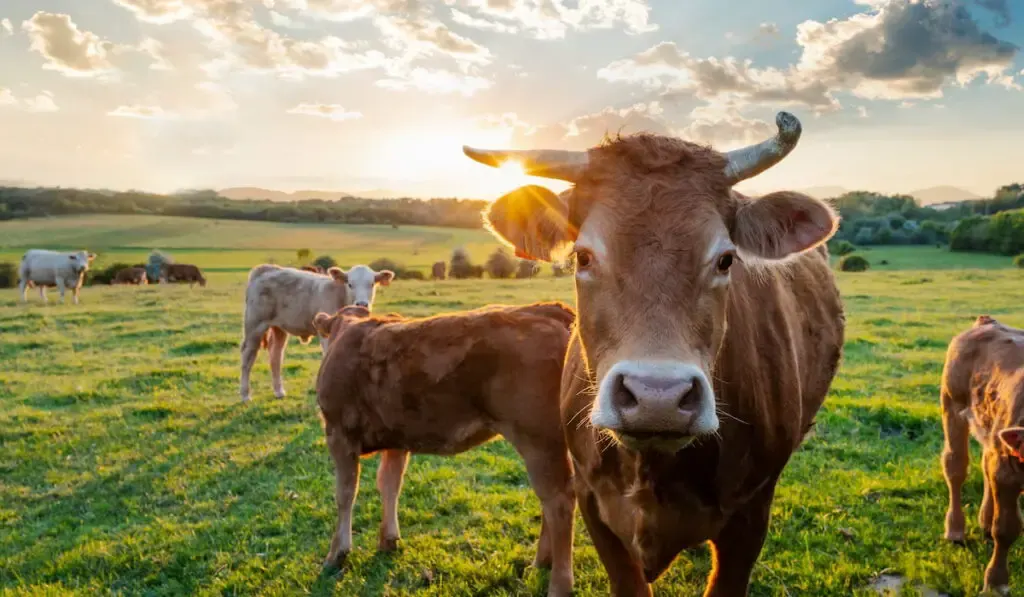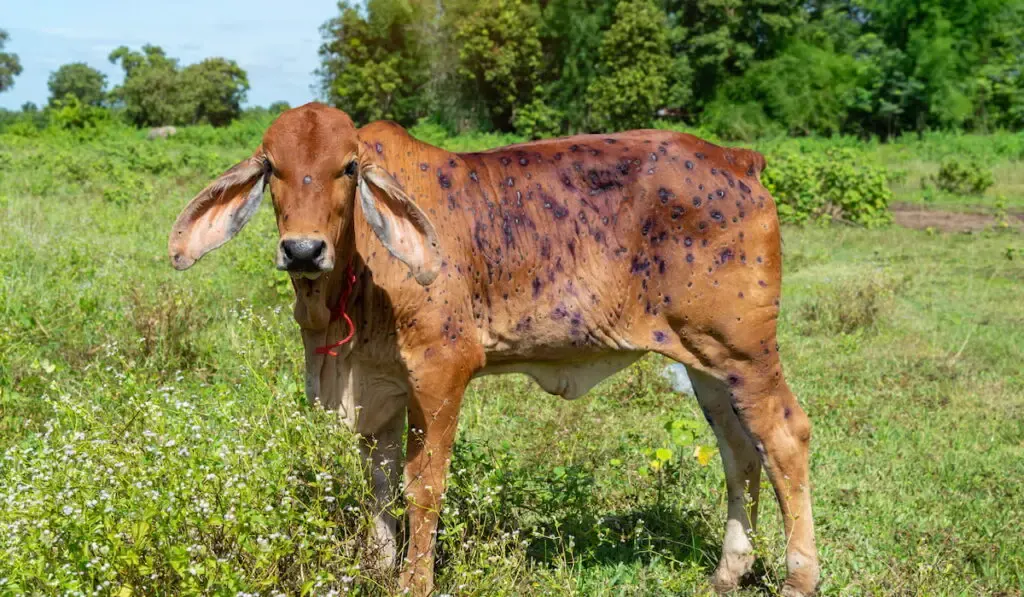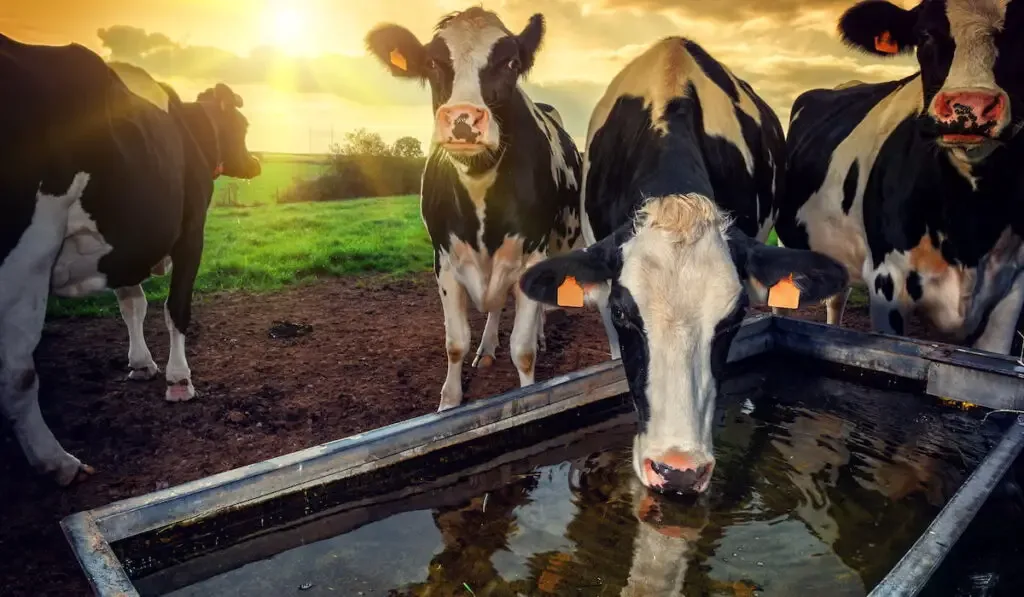Cows are one of the biggest sources of meat for humans since before written history. Cows as we know them are descended from aurochs, which were wild oxen. But if we look back at their history, the domestication of cows can be traced back over 10,500 years ago to the region of southern Turkey.
More recently, the first group of domesticated cows was brought to the United States in 1624 by the pilgrims who settled Plymouth Colony. Presently, there are many cow breeds around the world that are raised and used for different purposes.
Raising cows is a big commitment and could be a challenge for some people. But armed with the right knowledge, you can definitely raise these bovines and, if you have the space, grow from a few cows into a much larger herd.
In this article, we will focus on all the important aspects of raising cows. You will find this guide is practical and useful, both for experienced breeders and passionate beginners.

Choosing The Best Breed: Meat, Dairy, and Dual Purpose Cows
Buying cows isn’t something that you can decide quickly. Some breeds cost more than others, especially the imported ones. You have to do your own due diligence to avoid expensive mistakes that you’ll end up regretting.
Before making a purchase, you should always have a clear goal on what you want out of these animals. There are meat cows, dairy cows, and dual-purpose breeds.
This table show some of the popular cow breeds in the United States that you can raise and their main purpose:
| Breeds | Height | Weight | Purposes |
| Angus | 5 – 6 ft | 1,000 – 1,200 lbs | Meat |
| Ayrshire | 4.1 – 4.4 ft | 1,000 – 1,300 lbs | Dairy |
| American Brahman | 4 – 6 ft | 1,000 – 1,400 lbs | Meat |
| Brown Swiss | 4.4 – 4.6 ft | 1,100 – 1,500 lbs | Dairy |
| Charolais | 4.4 – 4.9 ft | 1,250 – 1,600 lbs | Meat |
| Dexter | 2.8 – 3.8 ft | 800 – 1,000 lbs | Dairy and meat |
| Florida Cracker | 2.6 – 3.5 ft | 600 – 1,000 lbs | Meat |
| Galloway | 3.6 – 3.9 ft | 1,000 – 1,500 lbs | Meat |
| Gelbveich | 4.6 – 4.8 ft | 1,433 – 1,873 lbs | Meat |
| Guernsey | 4.5 – 4.7 ft | 992 – 1,212 lbs | Dairy |
| Hereford | 4.5 – 4.6 ft | 1,000 – 1,200 lbs | Meat |
| Highlands | 3 – 3.5 ft | 900 – 1,200 lbs | Meat |
| Holstein | 4.5 – 4.9 ft | 1,212 – 1,278 lbs | Dairy |
| Jersey | 4 – 4.2 ft | 881 – 1,102 lbs | Dairy |
| Limousin | 4.4 – 4.7 ft | 1,322 – 1,433lbs | Meat |
| Shorthorns | 4.3 – 4.6 ft | 1,410 – 1,500 lbs | Dairy and meat |
| Simmental | 4.4 – 4.9 ft | 1,543 – 1,984 lbs | Dairy and meat |
| Texas Longhorn | 4.3 – 4.6 ft | 800 – 1,500 lbs | Meat |
No matter which breed you choose, be sure to select animals that are healthy. One to thing consider when choosing healthy cows is that their vision is bright and clear. Healthy cows should be alert and sensitive to their surroundings, but not the point of being wild.
Their breathing should also be smooth without any irregularities or coughing. There should be no signs of physical deformities and malnutrition.
Another important factor that plays a major role in selecting your breed would be your location. Cows thrive in environments that are suited to their bodies.
If you live in a hot and arid area like Florida or Texas, heat-tolerant breeds like the Brahmas or Jerseys would be the best choice.
Avoid furry cows, especially the ones with black fur that would absorb too much heat and cause them to suffer from a heat stroke.
Lastly, it is always best for you to start with at least two or three cows. Raising a large herd can be quite an overwhelming task, so it is best to start with a small herd.
You can purchase a couple of weaned cows of around 6-months old. This is best the period where they are still young, healthy, and are easier to handle. The typical price for a commercial cow is around $1,000. Depending on their breed, the price could go up as far as $1,500 or$3,000 per animal.

Farm Setup: Fields, Fencing, and Housing
Cows are big animals. They need space to move, graze, and mingle with the rest of the herd. This is where the quality of your land or farm plays an important part in raising these animals.
Each cow needs at least an acre of land or space. If they give birth to a calf, then the space should be increase to two acres.
It is also beneficial to cows if your land is covered with different kinds of grasses, legumes, or weeds. Most of the time, cows will graze on the field or pasture and spend the rest of their day eating whatever plants they can find. They eat a lot and the quality of the plants they eat contributes to their overall well-being.
You can take a soil sample of the pasture and send it for a thorough analysis. This way, you will know what types of lime and fertilizer that you can use to promote the growth of high-quality forage.
The pasture should also be divided and separated into multiple pastures. This is where the use of multiple paddocks is important for rotational grazing.
Moving your herd from one paddock to another creates time for the pasture or grasses to regrow.
By doing this, you don’t have to worry about overgrazing issues and your cows will get all the food that they need.
Another thing you should have on your farm is good fencing. Fences are important to protect and keep the cows from moving too far. They will also notice and learn not to enter any prohibited areas that will cause further issues with your neighbor’s land.
Some of the fencing options that you can build are:
· Wooden Fencing
Setting up wooden fences can be quite expensive. This is because high-quality wood that can withstand different weathers, wear, and tear, is pretty expensive. But on the upside, they last longer and you don’t have to worry about any broken fences.
· Barbed Wire Fencing
Barbed wire fences are the best option when you are fencing acreage. What you need are at least four different wire strands. The bottom strand must be placed close to the ground to avoid leaving any crawling room for cows to escape.
Then, the top strand should be placed at least four feet tall. This will also prevent your cows from trying to jump over the fencing. Barbed wire fences are the most suitable option for pasture cows.
· Electrical Fencing
Electrical fences are great, provided that you can supply them with a steady source of electricity, be it from a generator, battery, or solar-powered panels. However, you should be careful if you live in a wet and rainy location when using a solar source you may have a difficult time maintaining enough charge in the fence to deter the cattle.
Tall bushes or growing grasses can also cause the wires to short out. So, a regular trim around the fences is pretty important.
Finally, pick the best fence posts for your farm. These include gates, corner posts, and middle posts where the strand or wire is long. Different posts made from different materials are available at any hardware store. Post materials range from metal, railroad ties, to cedarwood, fiberglass, and many more.
Once you have finished setting up the fences, it is time for you to build the shelter. Although cows are generally hardy, they still need proper housing that can shelter them from harsh weather.
Cows don’t need a complex barn or an enclosed structure. They just need a good three-sided shed or barn with proper ventilation.
This shelter can’t be air-tight because cows naturally give off a lot moisture and odor. Also, be sure that this cowshed is able to withstand strong wind and a sudden impact made by these animals, especially when they move around within it.

Feeding Habit: Diet and Nutrient Requirements
To grow healthily, cows need a balanced diet that supplies them with all the nutrients they need. These ruminants possess four-chambered stomachs that are well-equipped for digesting grasses and foliages. When they forage, they will get all the fiber they need.
But more often than not, fiber alone is not enough. They still need other nutrients like protein, vitamins, minerals, and other trace elements. When winter comes, grasses will go also dormant and you will have to feed them with dry feed.
If you are raising a small herd, haylage would be the best feed for your cows. These large, round, and marshmallow-like bales contain around 60 to 65% moisture, which is more than regular baled hay. They cost less and are also higher in protein count.
On the other hand, if haylage is hard to get in your location, you can still feed your livestock with regular hay.
Hay prices vary depending on where you live. They are usually sold by the bale. Hay prices vary widely from place to place and depend on the demand in the area and the weather conditions. If it has been a wet year and hay producers haven’t been able to harvest the hay, prices will be higher; a sunny, drier season brings more moderate prices.
One caution is if you feed alfalfa hay or haylage, be sure to control the amount that you give to prevent bloating.
There is nothing wrong with purchasing a lot of hay, especially when you are preparing to feed them for the winter. During this cold season, cows tend to eat more than usual to produce more heat for their bodies. You will also need a heater to prevent their water supply from becoming too cold or turning into solid ice.
Last but not least, keep their water supply fresh and clean. Generally, cows drink in large quantity and they are able to drink up to twenty gallons of water per day. A steady supply of freshwater can keep these animals hydrated.
Schedule regular cleaning of their waterer to prevent mold build-up that could contaminate their water. Certain types of molds are toxic and could potentially harm their digestive system.

Breeding and Calving
To breed your cows, you need a healthy bull in with your herd. If you don’t want to keep a bull year-round, you can lease one from another farm in your area. The gestation period of a cow is approximately nine months, very similar to a human.
When heifers reach the age of 13 to 15 months old, they are ready to be bred and you will have the first calf when they reach 2 years old. Plan the breeding schedule ahead to avoid hot weather that could put a strain on both the mother and her calf.
On the other hand, you can also opt for artificial insemination. This cow breeding method will carefully monitor the cows’ heat cycle and may make use of hormone injections to synchronize a herd to calve within a certain period of time. AI allows you to choose a sire for characteristics you wish to have in your herd and to better meat or milk production.
There are a few signs to look for when the cows reach a period of giving birth. First, their udders start to swell. Then, the muscles and ligaments around their pelvic bones and vulva begin to relax. The teats will also begin to produce colostrum, which is nutritious milk for calves. The mother will lie down and push the calf out unassisted when it gives birth.
Normally, the calf comes with its front feet with its head resting on the front legs. However, if the calf is still in this position and the mother stops pushing it out, then it is time for your to call the vet for help. After the calf comes out, the amniotic sac that covers its body has to be ripped so it can breathe without any restriction.
Generally, after 20 to 30 minutes of being born, healthy calves will stand and walk slowly. You can monitor them and the mother over the next few days for any complications.

Milking Your Cows
When you raise dairy cows, it is advantageous if you know how to milk them by hand. Of course, this skill is quite easy and can be learned by almost anyone. What you need are a few things: a barn or shed for the milking process, a small bench for you to sit on, and a bucket for the milk.
To milk your cows, good hygiene should be your first priority. Wash your hands thoroughly and make sure the cow’s udder is also clean and dry. At first, squirt the milk out into another bucket. This will clean out any bacteria that linger around the teat.
Then, grab the upper part of the teat to prevent the milk from moving up into the udder. Using your other hand, squeeze the milk down slowly until the milk comes out of the teat. Repeat this process until no milk is left.
Always place the bucket right under the udder or close to the cow’s teat to prevent any spillage. If possible, avoid milking your cows out in the open space or inside a barn without walls. This is to prevent any debris or dirt that could contaminate the milk.
Processing the Cows
According to the USDA, cows generally can be slaughtered around the age of 32 to 42 months old. This might vary depending on each breed and how healthy when they mature.
In certain cases, calves can also be slaughtered depending on their age. They are called veal calves. Normally, veal calves are slaughtered when they reach six to eight months old. However, there are three veal categories.
For instance, bob veal calves can be slaughtered at only a few months old. Their meat is often pale in color and very tender. Normal veal can be slaughtered around the age of six to eight months old. Finally, rose veal is the oldest category, which is eight to twelve months old.
Aside from meat cows, older dairy cows can also be slaughtered once they can’t produce any milk or aren’t able to give birth. Usually, their fertility starts to drop off when they reach six to eight years old. But for any cow breed, the general rule of thumb for the most optimum slaughtering age is between 32 to 42 months old.

Health Issues in Cows
Keeping your cows healthy isn’t just about watching their diet or providing a stress-free environment. Although those things are important to keep them healthy, there are other internal health issues that these animals could suffer from. Some of these are:
· Footrot
Footrot happens commonly in winter and fall. It can be recognized by symptoms such as limping, inflammation, swelling, bad odor on the feet, and redness between the cow’s toes. This disease can be treated by administering antibiotics provided by the veterinarian, separating the infected cows into another pen, and trimming the infected areas on the cow’s feet.
· Brucellosis
Brucellosis is one of the infectious diseases caused by bacteria, Brucella. Even today, there is still no treatment for this disease.
In bulls, this disease can be recognized by testicular swelling. In cows, symptoms of brucellosis appear as infection in the placenta, weak calves at birth, abortion, and stillborn calves. To combat this issue, breeders and farmers take these animals for vaccination and keep the barn or cowsheds clean and sanitized.
· Scours
Scours is severe diarrhea that comes with many symptoms. For instance, cows with scours will lose their appetite, become dehydrated, and liquid discharge will come out of their bodies, usually in whitish or grayish color.
Scours generally happens in cows and calves when they drink from a dirty waterer or eat from a contaminated feeder. This illness can be treated using antibiotics suggested by a veterinarian, electrolytes, and anti-diarrheal medication.
· Mastitis
Mastitis in cows happens when their udders become inflamed due to bacterial infection or severe injuries. This condition will affect milk production, changing the texture and nutrient composition of the milk while causing some pain to their udders.
Generally, you will have to consult with a veterinarian to treat this issue and they will administer NSAIDs (Non-steroidal anti-inflammatory drugs) or other medication to help alleviate the pain.
· Strongyle worms
This parasite is one of the most common roundworms found in livestock. Strongyle worms could cause weight loss, lesions, diarrhea, and a decrease in the production of the cows.
Symptoms of strongyle worms in cows include paleness inside of eyelids and in the gums, anemia, lethargy, and skin lesions.
This issue can be treated by scheduling a regular deworming to remove and kill this parasite.
Once the cows have been treated, be sure to rotate between each pasture and use a feeder to avoid direct feeding from the ground.
As with any other disease, always consult a veterinarian before taking any actions that could jeopardize the health of these animals.

Final Thoughts
Just like other livestock, raising cows can supply your family with a sustainable source of homegrown meat or milk over a long period of time. As your herd grows larger, you will have decisions to make depending on the space you have available and your budget. Overcrowding of pastures and shelters can lead to pest and disease issues.
When you take the time to choose the right breed for your area and purpose, raising cattle can be rewarding and fulfilling. Use this article as a guideline to plan for adding cows to your homestead.
Citations
- https://www.motherearthnews.com/homesteading-and-livestock/raising-dairy-cows-zmaz81jazraw
- https://www.motherearthnews.com/homesteading-and-livestock/raising-your-own-beef-for-food-zmaz02amzgoe
- https://www.hobbyfarms.com/the-beginning-farmers-guide-to-raising-backyard-beef-3/
- https://faunafacts.com/cows/raise-a-cow-for-slaughter/
- https://www.hobbyfarms.com/want-to-keep-a-family-milk-cow-heres-how/
- https://extension.oregonstate.edu/sites/default/files/documents/11866/dairy-cow-doc.pdf
- https://insteading.com/blog/getting-started-with-raising-cattle/
- https://www.fromscratchmag.com/raise-cattle-small-acreage/
- https://hellohomestead.com/12-things-to-know-about-raising-cows/
- https://thisnzlife.co.nz/a-beginners-guide-to-raising-calves-for-beef-which-breeds-to-choose-sourcing-stock-and/
